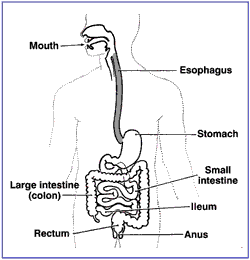The changes associated with aging of the digestive system are largely caused by decreased nerve sensitivity, loss of muscle tone, and increased susceptibility to bacterial infection because of a weakened immune system. Thus, changes include loss of strength and tone of muscular tissue and supporting muscular tissue, decreased secretory mechanisms, decreased motility of the digestive organs, along with changes in neurosensory feedback regarding enzyme and hormone release, and diminished response to internal sensations and pain.
In the upper GI tract common changes include:
- periodontal disease, which is caused by bacterial infection and affects alveolar bone, periodontal ligament, cementum, and/or gingiva.
- difficulty in swallowing due to loss of muscle tone.
- reduced sensitivity to mouth irritations and sores, likely caused by nerve damage.
- loss of taste, which can be caused by local damage and inflammation that interferes with the taste buds stemming from radiation therapy, tobacco use, and denture use.
- gastritis, which is an inflammation of the lining of the stomach and can develop after traumatic injury or severe infections.
- peptic ulcer disease, largely due to weakened immune systems unable to clear the bacterial infection.
Changes that may appear in the small intestine include:
- appendicitis
- duodenal ulcers
- malabsoration of nutrients due to a variety of causes, including inflammatory bowel diseases, radiation enteritis, digestive failure, and malnutrition.
- maldigestion.
Other pathologies that increase in occurrence with age are acute pancreatitis, jaundice, and gallbladder problems. Large intestinal changes such as hemorrhoids and constipation may also occur. Cancer incidence in general increases with age and cancers of the rectum are quite common.

Digestive Tract
Several aspects of the digestive tract are labeled in this cartoon.